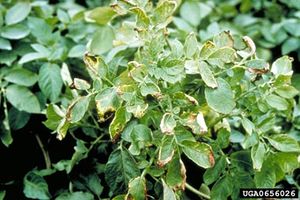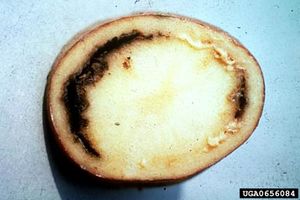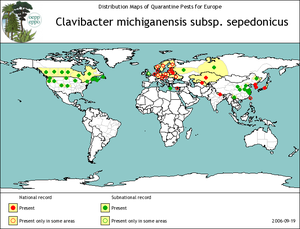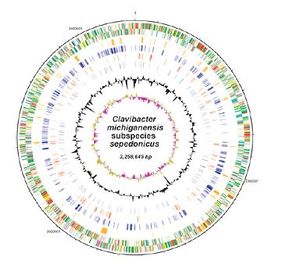Clavibacter michiganensis
Classification
Domain: Bacteria, Phylum: Actinobacteria, Class: Actinobacteria, Subclass: Actinobacteridae, Order: Actinomycetales, Suborder: Micrococcineae, Family: Microbacteriaceae, Genus: Clavibacter, Species: michiganensis, Subspecies: sepedonicus
Note: Genus Clavibacter was historically Corynebacterium. Clavibacter michiganensis subsp. sepedonicus has historically been referred to as Corynebacterium sepedonicum.
Species
Clavibacter michiganensis subsp. sepedonicus
Description and Significance
Describe the appearance, habitat, etc. of the organism, and why you think it is important.
Genome Structure
The complete genome of Clavibacter michiganensis subsp. sepedonicus has been sequenced. It is reported that the genome consists of a singular circular chromosome (3,258,645 bp, 72.56 % G+C, 3016 genes), a linear plasmid (pSCL1) (94,603 bp, 68.83 % G+C) and a circular plasmid (pSCL1)(50,350 bp, 67.46 % G+C). (National Center for Biotechnology Information Center (NCBI)) Pathogenicity is believed to be associated with the two plasmids, pSC1 and pSCL1 (NCBI). The chromosome codes for numerous antibiotic resistance-related genes, as well as many genes relevant to microbial ecology. Some of these genes are used to withstand low iron and oxidative stresses, including: siderophore binding and biosynthesis proteins, iron uptake permease, heavy metal detoxification proteins, catalase, numerous peroxidases and superoxidase dismutases, hydroperoxide resistance proteins, heme-binding proteins, iron-chelating proteins, copper resistance surface proteins, a manganese catalase, an iron-siderophore uptake system and pectate lyase proteins (Bentley 2008).
Cell Structure, Metabolism and Life Cycle
Clavibacter michiganensis subsp. sepedonicus is a gram positive bacteria (Li and Deboer, 1995). It is pleomorphic, slightly club-shaped short rod and this rod size is about 0.5 - 1.0 µm. C.m. sepedonicus is aerobic pathogen but it also can grow slowly in anaerobic condition. The isolated colonies are often yellow, creamy and smooth (Van der Wolf J.M et al, 2005). C.m. sepedonicus infects the healthy plant through wounds. It moves from plant to plant in irrigation water or insect vectors such as Colorado potato beetles and flea beetles. C.m. sepedonicus is soil invader pathogen. The pathogens overwinter in tuber seeds and favor in high temperature at the end of growing season. It can survive in tuber seeds, plant debris and on agricultural equipments. It can survive up to 10 days in surface water and up to 5 years in dried and cold climate (Sparks A. and Megan K., 2008) and. However, if the temperature increases up to 150C, the pathogen can survive only for few weeks (Van der Wolf J.M. et al, 2005). The C.m. sepedonicus gene was found 90% identity of Clavibacter michiganensis subsp. Michiganensis. This gene was found in a protein which was coded from over 700 amino acids (Van der Wolf J.M et al, 2005).
Ecology and Pathogenesis
C.m. sepedonicus's infection is mainly on potato, less in tomato and eggplant, sometime in root of sugar beet. In potato, it causes ring rot in tuber seeds. This disease was first found in Germany in the late 1800's. Then the pathogen was presented into United States in the early 1930's and spread out whole the country by 1940's (Randall C. Rowe et al, 1995). The disease severity can cause wilting of leaf and stem, chlorosis and necrosis from leaf margins. C.m. sepedonicus produces amylase and cellulase enzymes. Amylase enzyme is used to break drown starch into sugar and cellulase is responsible for the hydrolysis of the cellulose polymer into dimeric subunits. Cellulase was also proven as an important virulence factor for C.m. sepedonicus (Van der Wolf J.M et al, 2005).
References
Li X.A., Deboer S.H. (1995). Selection of polymerase chain-reaction primers from an RNA intergenic spacer region for specific detection of Clavibacter michiganensis subsp. sepedonicus. Phytopathology 85:837-842.
Randall C. Rowe , Sally A. Miller, Richard M. Riedel, 1995. Bacterial Ring Rot of Potatoes. Ohio State University Extension Fact Sheet HYG-3103-95
Sparks A. and Kennelly M. (2008). Bacterial Ring Rot of Potato, Kansas State University, August 2008.
Van der Wolf J.M., Elphinstone J. G., Stead D. E., Metzler M., Muller P., Hukkenen A., Karjalainen R., 2005. Epidemiology of Clavibacter Michiganensis subsp. sepedonicus in relation to control of bacterial ring rot. Plant Research International B.V., Wageningen.
Katherine's References
Bentley, SD, et al.. 2008. Genome of the actinomycete plant pathogen Clavibacter michiganensis subsp. sepedonicus suggests recent niche adaptation. J Bacteriol. 2008 Mar;190(6):2150-60.
National Center for Biotechnology Information (NCBI). Accessed April 2010.
Author
Page authored by Ninh Hoang and Katherine Ivens, students of Prof. Jay Lennon at Michigan State University.




